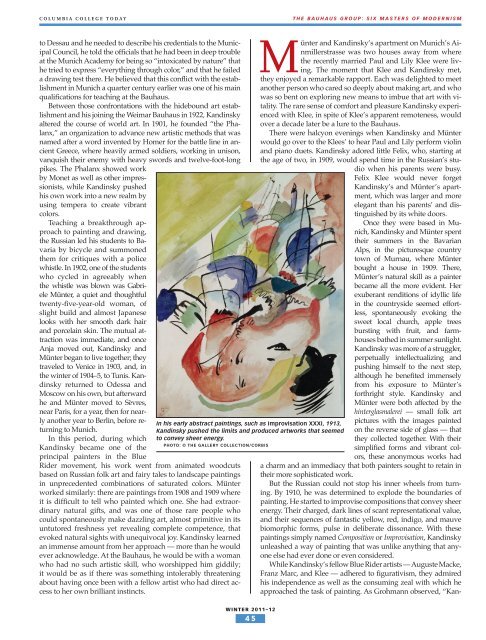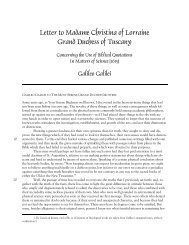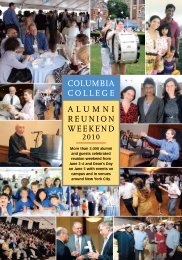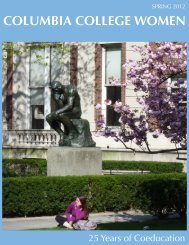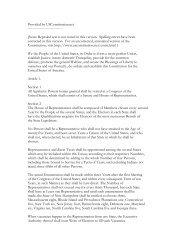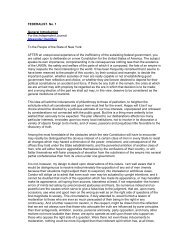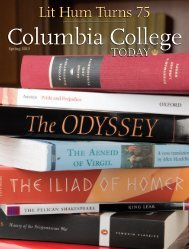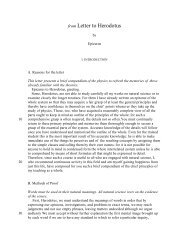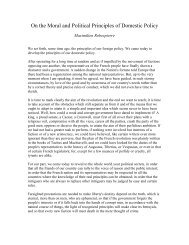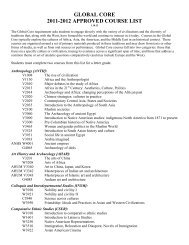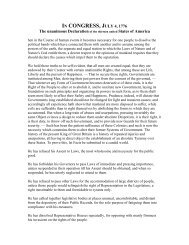Japan Storm - Columbia College - Columbia University
Japan Storm - Columbia College - Columbia University
Japan Storm - Columbia College - Columbia University
You also want an ePaper? Increase the reach of your titles
YUMPU automatically turns print PDFs into web optimized ePapers that Google loves.
COLUMBIA COLLEGE TODAY THE BAUHAUS GROUP: SIX MASTERS OF MODERNISM<br />
to Dessau and he needed to describe his credentials to the Municipal<br />
Council, he told the officials that he had been in deep trouble<br />
at the Munich Academy for being so “intoxicated by nature” that<br />
he tried to express “everything through color,” and that he failed<br />
a drawing test there. He believed that this conflict with the establishment<br />
in Munich a quarter century earlier was one of his main<br />
qualifications for teaching at the Bauhaus.<br />
Between those confrontations with the hidebound art establishment<br />
and his joining the Weimar Bauhaus in 1922, Kandinsky<br />
altered the course of world art. In 1901, he founded “the Phalanx,”<br />
an organization to advance new artistic methods that was<br />
named after a word invented by Homer for the battle line in ancient<br />
Greece, where heavily armed soldiers, working in unison,<br />
vanquish their enemy with heavy swords and twelve-foot-long<br />
pikes. The Phalanx showed work<br />
by Monet as well as other impressionists,<br />
while Kandinsky pushed<br />
his own work into a new realm by<br />
using tempera to create vibrant<br />
colors.<br />
Teaching a breakthrough approach<br />
to painting and drawing,<br />
the Russian led his students to Bavaria<br />
by bicycle and summoned<br />
them for critiques with a police<br />
whistle. In 1902, one of the students<br />
who cycled in agreeably when<br />
the whistle was blown was Gabriele<br />
Münter, a quiet and thoughtful<br />
twenty-five-year-old woman, of<br />
slight build and almost <strong>Japan</strong>ese<br />
looks with her smooth dark hair<br />
and porcelain skin. The mutual attraction<br />
was immediate, and once<br />
Anja moved out, Kandinsky and<br />
Münter began to live together; they<br />
traveled to Venice in 1903, and, in<br />
the winter of 1904–5, to Tunis. Kandinsky<br />
returned to Odessa and<br />
Moscow on his own, but afterward<br />
he and Münter moved to Sèvres,<br />
near Paris, for a year, then for near-<br />
ly another year to Berlin, before returning<br />
to Munich.<br />
In this period, during which<br />
Kandinsky became one of the<br />
principal painters in the Blue<br />
Rider movement, his work went from animated woodcuts<br />
based on Russian folk art and fairy tales to landscape paintings<br />
in unprecedented combinations of saturated colors. Münter<br />
worked similarly: there are paintings from 1908 and 1909 where<br />
it is difficult to tell who painted which one. She had extraordinary<br />
natural gifts, and was one of those rare people who<br />
could spontaneously make dazzling art, almost primitive in its<br />
untutored freshness yet revealing complete competence, that<br />
evoked natural sights with unequivocal joy. Kandinsky learned<br />
an immense amount from her approach — more than he would<br />
ever acknowledge. At the Bauhaus, he would be with a woman<br />
who had no such artistic skill, who worshipped him giddily;<br />
it would be as if there was something intolerably threatening<br />
about having once been with a fellow artist who had direct access<br />
to her own brilliant instincts.<br />
In his early abstract paintings, such as Improvisation XXXI, 1913,<br />
Kandinsky pushed the limits and produced artworks that seemed<br />
to convey sheer energy.<br />
PHOTO: © THE GALLERY COLLECTION/CORBIS<br />
WINTER 2011–12<br />
45<br />
Münter and Kandinsky’s apartment on Munich’s Ainmillerstrasse<br />
was two houses away from where<br />
the recently married Paul and Lily Klee were living.<br />
The moment that Klee and Kandinsky met,<br />
they enjoyed a remarkable rapport. Each was delighted to meet<br />
another person who cared so deeply about making art, and who<br />
was so bent on exploring new means to imbue that art with vitality.<br />
The rare sense of comfort and pleasure Kandinsky experienced<br />
with Klee, in spite of Klee’s apparent remoteness, would<br />
over a decade later be a lure to the Bauhaus.<br />
There were halcyon evenings when Kandinsky and Münter<br />
would go over to the Klees’ to hear Paul and Lily perform violin<br />
and piano duets. Kandinsky adored little Felix, who, starting at<br />
the age of two, in 1909, would spend time in the Russian’s studio<br />
when his parents were busy.<br />
Felix Klee would never forget<br />
Kandinsky’s and Münter’s apartment,<br />
which was larger and more<br />
elegant than his parents’ and distinguished<br />
by its white doors.<br />
Once they were based in Munich,<br />
Kandinsky and Münter spent<br />
their summers in the Bavarian<br />
Alps, in the picturesque country<br />
town of Murnau, where Münter<br />
bought a house in 1909. There,<br />
Münter’s natural skill as a painter<br />
became all the more evident. Her<br />
exuberant renditions of idyllic life<br />
in the countryside seemed effortless,<br />
spontaneously evoking the<br />
sweet local church, apple trees<br />
bursting with fruit, and farmhouses<br />
bathed in summer sunlight.<br />
Kandinsky was more of a struggler,<br />
perpetually intellectualizing and<br />
pushing himself to the next step,<br />
although he benefited immensely<br />
from his exposure to Münter’s<br />
forthright style. Kandinsky and<br />
Münter were both affected by the<br />
hinterglasmalerei — small folk art<br />
pictures with the images painted<br />
on the reverse side of glass — that<br />
they collected together. With their<br />
simplified forms and vibrant colors,<br />
these anonymous works had<br />
a charm and an immediacy that both painters sought to retain in<br />
their more sophisticated work.<br />
But the Russian could not stop his inner wheels from turning.<br />
By 1910, he was determined to explode the boundaries of<br />
painting. He started to improvise compositions that convey sheer<br />
energy. Their charged, dark lines of scant representational value,<br />
and their sequences of fantastic yellow, red, indigo, and mauve<br />
biomorphic forms, pulse in deliberate dissonance. With these<br />
paintings simply named Composition or Improvisation, Kandinsky<br />
unleashed a way of painting that was unlike anything that anyone<br />
else had ever done or even considered.<br />
While Kandinsky’s fellow Blue Rider artists — Auguste Macke,<br />
Franz Marc, and Klee — adhered to figurativism, they admired<br />
his independence as well as the consuming zeal with which he<br />
approached the task of painting. As Grohmann observed, “Kan-


